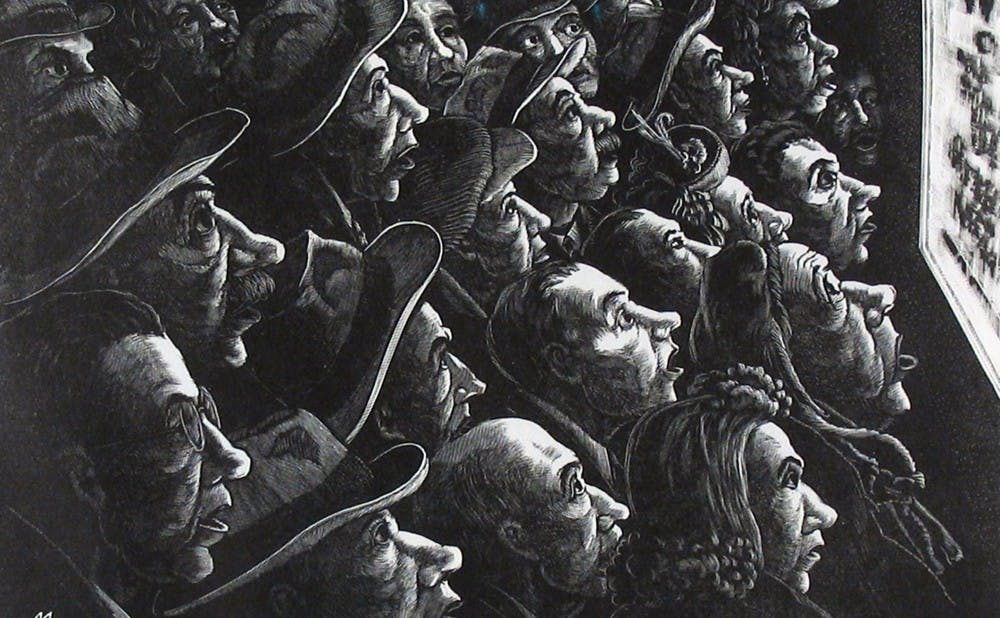A group of strangers crowd into a New York City subway car. It’s the ‘40s, and you can tell by the way everyone’s dressed. A woman on the far left wears a thick cross around her neck, but it doesn't stop her clinging velvet gown from partially exposing her breasts. She’s talking to another woman who’s too focused on taking in the gossip to notice the child tugging on her thick fur coat. Her socially superior analog to the right wears a look of judgment as she cradles her blonde-haired daughter. Another man is wary in his fedora and circular glasses, but much less so than the elderly woman who exhibits her discomfort with a sharp glare at the two chatterboxes. The only passengers who aren't visibly disgruntled by the duo are a fast-asleep construction worker and a bearded grump engrossed in that day’s paper.
This wood etching made me wonder when talking on the subway became so taboo. It was the first piece I saw in “America Seen: The Hunter and Cathy Allen Collection of Social Realist Prints,” which recently debuted at the University of North Carolina at Chapel Hill’s Ackland Art Museum.
“America Seen” offers glimpses of everyday life in the United States. The series enriches the Ackland's already well-established archive that houses North Carolina’s most extensive collection of European and American prints. Stretching from the 1920s to the 1940s and addressing various aspects of geography, race, class and time, the collection covers a broad chunk of history that would become formative to our current generation of American culture.
“Give Us This Day” by John Stockton de Martelly is one of the darker pieces in the collection. It shows three women gloomily draped across a kitchen table. The dreary looks on their faces tell us how they feel about sharing the measly bowl of watered-down soup they see before them, but it’s their only means of sustenance in a troubled economic climate. The room abounds with dozens of empty plates, and an open window in the background reveals a barren farmland implying a scarce harvest.
Howard Baer’s “Gladys” is a lithograph piece portraying Gladys Bently, a popular blues singer during the Harlem Renaissance. The outspoken lesbian was known to wear tuxedos and top hats while performing throughout New York City’s speakeasies and jazz clubs, and the piece captures her unapologetic presence by positioning her at the center of a jazz club packed with jiving patrons. This is one of the few pieces in the series that captures a more complicated live action shot, and it looks as though everyone in the frame slants to the left while swaying to Gladys’s bluesy ballads.
In addition to showing several vantage points of American life, “America Seen” exhibits a diverse set of mediums that include lithography, wood etchings and engravings. It’s easy to think of these pieces as remnants of a distant past, but they also highlight many parallels to our present, especially in depicting economic disparity.
“New York” is an exaggerated depiction of Manhattan by Ralph Della-Volpe. The modernist lithograph piece shows a cluster of curved skyscrapers, each one towering above the next. A flock of blackbirds weaves through the dizzying maze of buildings, but not nearly high enough to soar past the ominous center tower. This piece stands out by featuring an almost absurdist take on scale and depth, and qualities that highlight this perspective include topsy-turvy towers that might tumble sideways at any moment, a lone steamboat seeping its way through a canal-like opening into Manhattan’s underground, and a cartoonish winding road that disappears into a sea of high-rises.
“America Seen” presents various scenes that fluctuate in mood, from despairing pieces depicting economic depression to lighter images of bustling jazz clubs or city traffic. While subject matter varies throughout the collection, a palpable sense of humanity shows itself in each piece, providing a timeless and reliable link to the present.
"America Seen: The Hunter and Cathy Allen Collection of Social Realist Prints" is on show at the Ackland Art Museum until April 13. For more information, visit the museum website at http://ackland.org/exhibition/america-seen/.
Get The Chronicle straight to your inbox
Signup for our weekly newsletter. Cancel at any time.

